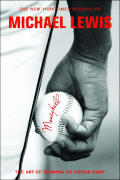
| Publisher: | W.W. Norton |
| Copyright: | 2003, 2004 |
| Printing: | 2004 |
| ISBN: | 0-393-32481-8 |
| Format: | Trade paperback |
| Pages: | 316 |
Everything that you were taught about baseball statistics, and most of what the baseball commentators on television and radio talk about, is either wrong or nearly worthless.
Moneyball has made quite a splash among baseball fans (and sparked some indignant anger from some parts of the baseball industry). It's in part the story of Billy Beane, the general manager of the Oakland A's, the story of how the A's manage to be a competitive playoff team despite having one of the smallest payrolls in the league (a fourth that of the Yankees), and despite constant doomsaying from the league central offices. It's in part the story of the modern statistical analysis of baseball, what's known as sabermetrics after SABR, the Society for American Baseball Research. It's also in part an analysis of the baseball player trading market from the perspective of an author who's previously written books on the stock market and understands derivatives, inefficient markets, and overpriced goods and how this relates to baseball.
The foundation of the stories told here is the contention that the statistics that Major League Baseball has officially blessed are poor at best. Baseball is perhaps unique in major sports other than cricket in that a game is divided into statistically distinct plays involving a small number of players, thus making it unusually accessible to mathematical analysis. It also has a long history of record-keeping, even better now that people have started experimenting with other statistical measures and have started traking more basic data about games. That lets one form statistical hypotheses and then test them against real historical data, proving what statistics are actually useful.
The stock statistics don't hold up very well.
This has wide-ranging impact. One can see statistically that teams overpay for certain skills, which is a market inequity that a good baseball GM can exploit to build a better team for less money. Statistical analysis reveals that certain plays in baseball are far more important than people think (the walk) and some are much less important than people think (the steal). And through an application of this sort of knowledge, the Oakland A's have become an amazing story of success through very unconventional drafting, trading, and on-field policies.
Anyone who is at all interested in baseball should read this book, particularly if you think errors mean anything or whether you can tell how good a reliever is from how many saves they have. It's also a fascinating book if you're interested in more general questions of how one can measure performance and how people's instincts are often wrong. Unfortunately, since I'd like to recommend this book to friends who don't follow baseball, you do need to know baseball in order to understand it; it assumes the reader knows terms like ERA and RBI and all the basic rules of baseball.
While most of the claims here are backed up by facts, this isn't an objective defense of sabermetrics. It's a story with a definite point of view, and it's worth reading other perspectives to put these stories into perspective. The storytelling is very compelling, though, and very readable; Moneyball held my interest as well as a novel. I recommend the trade paperback edition, which has an epilogue talking about the reception of Moneyball since its original publication.
Reviewed: 2004-09-24